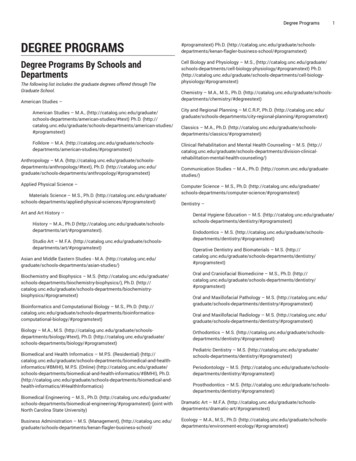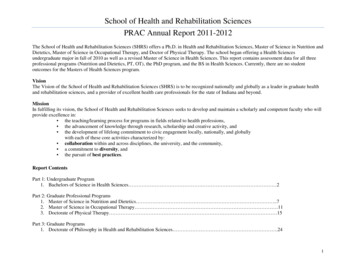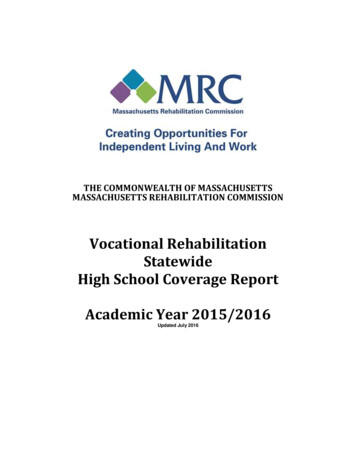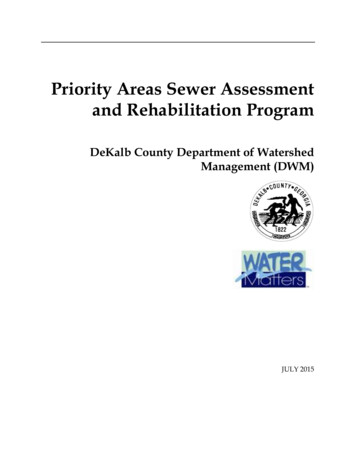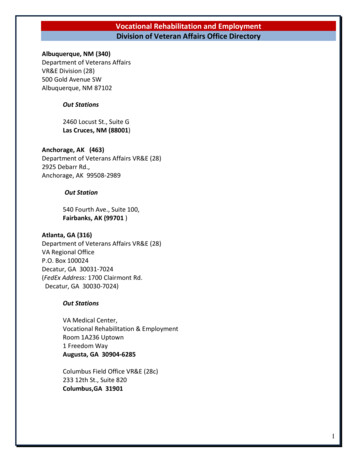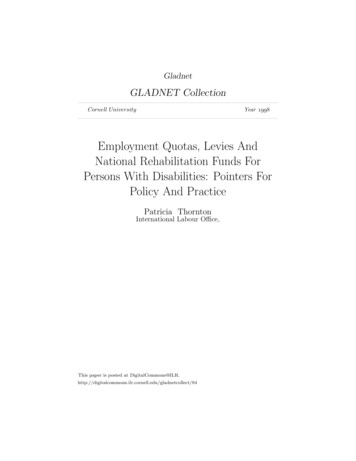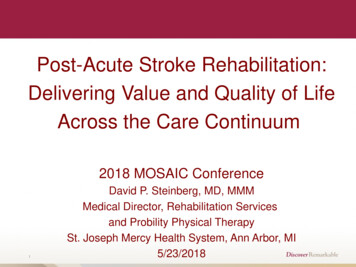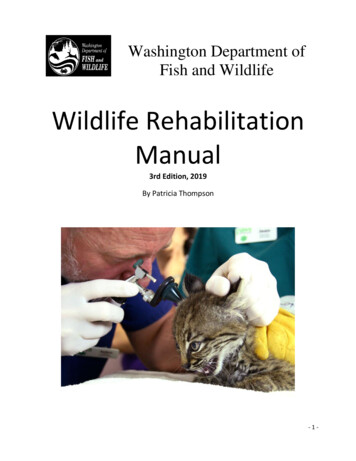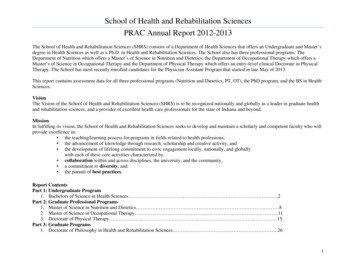
Transcription
School of Health and Rehabilitation SciencesPRAC Annual Report 2012-2013The School of Health and Rehabilitation Sciences (SHRS) consists of a Department of Health Sciences that offers an Undergraduate and Master’sdegree in Health Sciences as well as a Ph.D. in Health and Rehabilitation Sciences. The School also has three professional programs: TheDepartment of Nutrition which offers a Master’s of Science in Nutrition and Dietetics; the Department of Occupational Therapy which offers aMaster’s of Science in Occupational Therapy and the Department of Physical Therapy which offers an entry-level clinical Doctorate in PhysicalTherapy. The School has most recently enrolled candidates for the Physician Assistant Program that started in late May of 2013.This report contains assessment data for all three professional programs (Nutrition and Dietetics, PT, OT), the PhD program, and the BS in HealthSciences.VisionThe Vision of the School of Health and Rehabilitation Sciences (SHRS) is to be recognized nationally and globally as a leader in graduate healthand rehabilitation sciences, and a provider of excellent health care professionals for the state of Indiana and beyond.MissionIn fulfilling its vision, the School of Health and Rehabilitation Sciences seeks to develop and maintain a scholarly and competent faculty who willprovide excellence in: the teaching/learning process for programs in fields related to health professions, the advancement of knowledge through research, scholarship and creative activity, and the development of lifelong commitment to civic engagement locally, nationally, and globallywith each of these core activities characterized by: collaboration within and across disciplines, the university, and the community, a commitment to diversity, and the pursuit of best practices.Report ContentsPart 1: Undergraduate Program1. Bachelors of Science in Health Sciences .2Part 2: Graduate Professional Programs1. Master of Science in Nutrition and Dietetics 82. Master of Science in Occupational Therapy 113. Doctorate of Physical Therapy 15Part 3: Graduate Programs1. Doctorate of Philosophy in Health and Rehabilitation Sciences .261
School of Health and Rehabilitation SciencesPRAC Annual Report 2012-2013Part 1: Bachelor of Science in Health Sciences DegreeDepartment of Health SciencesMission: To prepare students at the baccalaureate level for advanced study and employment opportunities in the health sciences.Report Overview: The data below marks the first evaluation of the newly formed Health Sciences undergraduate program. The reportoutlines the three specific learning domains, their relationship to the PULs and specific learning objectives for each domain. Learningassessment techniques are provided as well as the benchmarks set by the department for each learning outcome. The most recentstudent outcome data appears in the outcome column and suggested changes for improvement for 2012-2013 are listed in the finalcolumn. This report represents the first analysis for the program; consequently, no follow up outcomes to the changes are reported.BUNDLEDomain I :Knowledgeof healthcare servicesin the world,populationhealth needs,and healthsciencesPULs1A – Express andinterpretinformation1C – Useinformationresourcesandtechnology2 - Criticalthinking3 – Integration &application ofknowledge.5 – Understandingsociety andcultureRISECOMPETENCIESStudents will be able to:AssessmentBenchmark * OutcomeChanges1.Describe health care professional jobs. (W100)Final examSee Note36%Revise approach tocontent and redesignfinal exam questions2.Identify current issues of critical importance inthe allied health professions. (W210)Exam #2See Note92%Met benchmark. Nochanges needed.Describe the roles and responsibilities ofhealth professionals. (W211)Career PaperSee Note100%Met benchmark. Nochanges needed.Comprehensive FinalExamSee Note82% FA82% SPContinue revisedapproach as previouslyinstituted. Provide studyguides for mid-term &final exams. Add oneopen forum for Q&Aprior to final exam.Final paperSee Note88%No change needed.3.4.5.Identify major global health challenges.(W250)Compare and contrast health professionsglobally. (W270)2
School of Health and Rehabilitation SciencesPRAC Annual Report 2012-20136.Demonstrate critical thinking & reflection ongerontology as a social, behavioral, andbiological science. (W310)Responsepapers #2 –Time to DieSee Note97%New faculty assigned.Apprise of previousresults.Final examSee Note100%Benchmark met. Nochange needed.CasemanagementpaperSee Note86%No changes needed.ResearchpaperSee Note81%Revise syllabus & rubricto clarify and be morespecific.10. Demonstrate knowledge regarding communityresources for older adults. (W350)Final examSee Note85%No change needed.11. Describe diverse populations in terms of valuesand perspectives related to culture, behaviorsand practices. (W361)Final paperSee Note89%No change needed.12. Describe the impact of policies, laws, andregulations on health and health care settingand providers. (W362)Final paperSee Note41% FA28% SPSchedule meetingsw/students to offerwriting guidance.Final paperSee Note85% FA89% SPNo change needed.Final examSee Note85% FA87% SPNo change needed.7.8.9.Explain the technology used in rehab. settings.(W320)Explore major issues in the rehabilitationadministrative environment. (W330)Describe different types of disabilities andsuccessful coping strategies. (W340)13. Describe application of ethical/moralprinciples. (W363)14. Explain the relationship of societalcircumstances on individuals with disabilities.(W364)3
School of Health and Rehabilitation SciencesPRAC Annual Report 2012-201315. Formulate strategies to address theinterrelationship of race, gender, culture, andethnicity in rehabilitative services. (W365)Group fieldassignmentpaperSee Note76% FA97% SPNo changes need.Final paperSee Note93%New instructor. Advisereg. outcome measures.Final paperSee Note62%Schedule meetingsw/students to encouragecompleting paper.Final paperSee Note85% FA85% SPNo change needed.PortfolioSee Note30%Change final assignmentto better reflect courseobjectives.16. Explain adult development and the agingprocess. (W370)17. Describe health professionals practicing indeveloping countries. (W380)18. Describe theories of administration andleadership in rehab. services. (W441)19. Explain relationship of aging on socialfunctions. (W450)Domain II :PracticalSkills andAbilities1A – Express andinterpretinformation1C – Useinformationresources andtechnology2 – Criticalthinking3 – Integration andapplication ofknowledge4 – Intellectualdepth, breadth,1.Evaluate the variation of operations amongvarious health facilities. (W410)AgencypaperSee Note89%No change needed.2.Write a grant. (W420)GrantproposalSee Note94%No change needed.3.Find, analyze, and summarize evidence on aself-selected health topic (W442)AnnotatedBib.See Note78% FA84% SPNo change needed.ProgramevaluationSee Note97%No change needed.4. Recognize, analyze, and evaluate health careservices. (W445)4
School of Health and Rehabilitation SciencesPRAC Annual Report oadDomain III:Responsibilities andPerformance5 – Values andethics5.Conduct literature searches on health topics.(W362;W380;W441;W450)JournalreportsSee Note34%50%74%40%Revise grading rubricsso students can selfassess reports beforesubmitting.6.Compare & contrast US health care systemwith that of a country visited. (470)Final paperSee Note0%Only one student incourse. No changeneeded.1.Demonstrate proper documentation in allwritten papers; avoid plagiarism.All coursepapersNoplagiarismNoneNo changes needed.2.Demonstrate integrity in completingassignments and taking exams; avoid cheating.Courseassignmentand examsNo incidentsreportedNoincidentsreportedNo changes needed.3.Maintain a CGPA greater than 2.0; avoidprobation.cGPA10% or lesson probationfor asemester8% FA10% SPIncrease outreach effortsto students to attendprobation meetings withacademic counselor.4.Maintain enrollment in Program untilgraduation; avoid dismissal.cGPA 1 %dismissedfrom theprogram1%No changes needed.5.Achieve high academic standard of 3.5 GPAeach semester.SemesterGPA5% orgreaterplaced onDean’s List16% FA18% SPNo change needed.6.(For students who choose to apply to graduateExit90% or60% ofEncourage students to5
School of Health and Rehabilitation SciencesPRAC Annual Report 2012-2013school or seek employment in the health caresystem), achieve acceptance or employment.7.(For those students who are enrolled in standalong certificates), complete one of threecertificates.interviewCompletionof requiredcertificatecoursesgreater gainentrance intograduateschool orhave securedemploymentrespondents.90%complete inthree years100%complete exit interview.No change needed.*For assessment noted, 90% of students must earn a grade of C or better.Review SummaryThe Health Science program demonstrated learning outcomes approaching targeted benchmarks. The faculty have outlined changes to includedifferent active learning activities (audiovisual materials), self-assessment strategies, grading rubrics, and policy changes to help students achievelearning outcomes. Follow up findings evaluating the impact of these changes will be reported next year.6
School of Health and Rehabilitation SciencesPRAC Annual Report 2012-2013Part 2: Graduate Professional ProgramsThe principles of graduate learning are listed below for both graduate and professional programs. Each of these goals is highly correlated toexisting graduate program goals for all disciplines within the School. Consequently, each of the goals below is numbered and linked to existinggoals within each assessment data table. Goal association is marked as PGL (Principles of graduate learning) and then the corresponding number.Principles of Graduate and Professional LearningGraduate students earning an Indiana University or Purdue University Ph.D. on the IUPUI campus will demonstrate the followingabilities related to the research focus of the degree:1. Demonstrate the knowledge and skills necessary to identify and conduct original research, scholarship or other creative endeavorsappropriate to the field2. Communicate effectively high level information from their field of study3. Think critically and creatively to solve problems in their field of study4. Conduct research in an ethical and responsible mannerGraduate students in professional graduate programs on the IUPUI campus will demonstrate the following abilities:1. Demonstrate the knowledge and skills needed to meet disciplinary standards of performance, as stated for each individual degree2. Communicate effectively with their peers, their clientele, and the general public3. Think critically and creatively to improve practice in their field4. Meet all ethical standards established for the discipline7
School of Health and Rehabilitation SciencesPRAC Annual Report 2012-2013Department of Nutrition and Dietetics2010-2011Program: Dietetic Internship ProgramMission: The mission of the Dietetic Internship Program is to provide advanced education and supervised practice opportunities for future leadersin the application and advancement of dietetics.Report Overview: This year’s report will focus on Scientific and Evidence Based Practice student learning objectives for the program.1.Student Educational GoalsGoal 1: The overriding goal of the Dietetic Internship Program is toassist the dietetic intern in making the transition from student toprofessional.2.Dietetic Internship Educational Program Plan12 weeks of food systemsmanagement including extendedcareGoal 2: Provide qualified healthcare professionals to serve the needs of the citizensof Indiana.15 weeks of medical nutritiontherapy including specialexperiences in pediatrics, diabetesclinics and renal outpatient clinics.3. Competencies/Learning OutcomesScientific and Evidence Base of Practice: integration ofscientific information and research into practiceDI 1.4 Evaluate emerging research for application in dieteticspractice.6 weeks of community nutritionincluding WIC clinics, homedelivered meals, congregatefeeding, community clinics, foodbanks, soup kitchens and schoolfeeding.The concentration in Clinical andCustomer Service is the final fourweeks of the Dietetic InternshipProgram.4. Target Benchmark5. Outcomes 2013100% of all interns will receive a C or betterin each course listed.We returned to our traditional schedule ofintroducing the research materials after earlyconcentration on medical nutrition therapyfoundation. This worked well and we wereable to select critical reading assignmentsfrom the Medical Nutrition Therapy literature.1.8
School of Health and Rehabilitation SciencesPRAC Annual Report 2012-2013With one or two exceptions, this dieteticintern class had a better grounding in criticalassessment skills that classes of previousyears. Target met2.Professional Practice Expectations: beliefs, values,attitudes and behaviors for the professional dietitian levelof practiceDI 2.2 Demonstrate professional writing skills in preparingprofessional communications (e.g. research manuscripts,project proposals, education materials, policies and procedures.100% of all interns will receive SatisfactoryScores (S) in SPR indicated.6. Program OutcomesThe Class of 2011 first time pass rate was 94% in contrast to the class of2010 whose first time pass rate was 65%. The Class of 2012 had a firsttime pass rate of 65% because they did not study sufficiently for theRegistration Examination for Dietitians. This gives our program a 5 yearfirst time passing rate of 80%. (2008-2012)Our first year post graduation passing rate for the same period (20082012) is 99% (n 80/81)99% (n 79/80) of all Dietetic Interns admitted from 2008 to 2012successfully completed the program in 15 months.100% of all 2011 graduates of the Dietetic Internship Program whoresponded to the 1 year post graduate survey reported that they weresatisfied or highly satisfied with their preparationAll employers who responded reported themselves satisfied with graduatepreparation and would hire again from our program.7.Interns were able to successfully demonstratecritical reading skills but needed coaching interms of following up on referenced studies.For example, they did not automatically lookup questionnaires etc utilized in studies todetermine whether they were appropriate.What program improvements have been made based onassessment findings?We shared the experience of the Classes of 2010 and 2011 with the classof 2012 and 2013. The class of 2012 saw itself as the exception and didnot believe that they would find the Registration Examination forDietitians challenging. Part of the difficulty is that newly graduateddietitians can work for as long as 6 months before being Registered. Inthe absence of state licensure, there is little penalty for failing the RDExam the first or even second time. We plan to make the final 6 weekinternship supervised practice experience graded rather than S/F and torequire all interns to complete the StEP: Student Exam Prep which is acomputer based preparation for the Registration Examination forDietitians. The final score on the StEP Exam will be count as 50% of the Capstone grade.No improvements needNo improvements needed9
School of Health and Rehabilitation SciencesPRAC Annual Report 2012-2013The most recent 5 year period 2008-2012, 85% of the Dietetic InternshipProgram graduates who sought employment were employed with in 3months following program completionNo improvements neededNo improvements needed8. Program improvements to be implemented in 2012-2013 to enhance student learningProgram Changes (2012-2013)A. We eliminated mandatory pretests infavor of self-evaluation and self-studyOutcomesInterns did not utilize the materials and turned up at supervised practice sites unprepared. As a result, pretests areback and will be administered using question data bases in OncourseWe planned to develop a facebook pagefor preceptorsThe initial steps to set up the facebook page were taken. It did not provide the level of flexibility we needed.Current plan is to utilize the drop box feature of the revised Oncourse and try those out this coming year.We completed a two week communitynutrition experience at the Indiana StateFair.Results were mixed. We found that without significant supervision and coaching many interns did not takeadvantage of learning opportunities. We decided to replace this rotation with other experiences because we werenot able to solve the supervision problem and the scheduling of the State Fair this year overlapped with otherteaching obligationsIn place of the Indiana State Fair Community Nutrition Experience we designed a Garden on the Go experiencewith IU and added a separate one week Nutrition Assessment Experience for the 2013-2014 year.Dietetic and Nutrition Report SummaryThe learning objectives represent a portion of the expected outcomes for the program based upon accreditation standards. Studentshave demonstrated an ability to achieve these student learning outcomes routinely. Although student performance has been successful,the faculty appreciate the need to continue to advance their educational approach. Therefore, the faculty will be making specificeducational changes that will attempt to impact student learning. Follow up data from these changes will be evaluated and reportednext year.10
School of Health and Rehabilitation SciencesPRAC Annual Report 2012-2013Department of Occupational TherapyMission: The mission of the Indiana University (IU) Department of Occupational Therapy (OT) is to provide a nationally recognized entry-level graduateprofessional program and advanced graduate education. Faculty and student scholarship increases opportunities for meaningful participation in individual, familyand community life. Through collaboration with colleagues across IUPUI and the professional community, we explore initiatives and disseminate knowledge andapproaches to improve overall health and quality of life for all persons. To this end, we embrace interdisciplinary and translational research as it relates to health,social participation, and rehabilitation sciences.1.Department of Occupational Therapy Student Educational GoalsIU OT graduates will reflect the values of the AOTA Centennial Vision by being science driven, occupation-focused, evidence-based, professionals who assistindividuals in meeting their occupational needs promoting participation at several levels. In concert with the IU Department of OT’s mission, graduating studentswill demonstrate professional reasoning, communication, and reflection (Schön, 1983)Learning OutcomesAssessment MethodsGoalResultsChanges1.Being mindful,reflective, ethicaland critical thinkingpractitioners.Reflective Seminar Grade80% of studentsreceive a grade of Bor higherClass of 2013 –100% ofstudents metgoalVery few students achieved below aA- grade. Faculty will re-evaluate goallevel to determine appropriatebenchmark level for this learningobjective. Faculty will also considerindividual seminar assignments formeasurement2.Anticipating,analyzing andaddressingoccupational needs& usingoccupation-basedinterventions.Occupation courses (I, II& III), TheoreticalFoundations of OT course& Technology in OTcourse grades80% of studentsreceive a grade of Bor higherClass of 2013 –81% ofstudents metgoalFew students received below a Bgrade. Faculty will re-evaluate goallevel to determine appropriatebenchmark. Faculty will discusspossible individual course outcomemeasurements for assessment aswell.11
School of Health and Rehabilitation SciencesPRAC Annual Report 2012-20133.Advocate,communicate andcontribute to OT inexisting andemerging practiceareasAlumni Survey80% agreement100%Will continue to monitor and consideradditional individual direct measur
Therapy. The School has most recently enrolled candidates for the Physician Assistant Program that started in late May of 2013. This report contains assessment data for all three professional programs (Nutrition and Dietetics, PT, OT), the PhD
